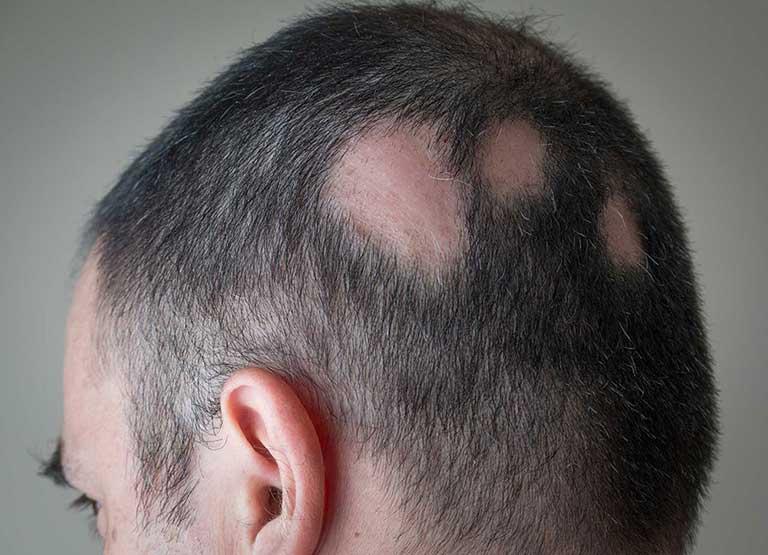Alopecia Areata
Find out what are the causes and effects of alopecia areata.

What is alopecia areata?
Alopecia areata is a common autoimmune disease that causes hair loss in small, round areas of the scalp, although, in some cases, it may also lead to generalized baldness. Skin patches affected by hair loss usually look normal and, although any hair of the body may be involved, these usually appear in the scalp and the beard.
At any given time, approximately 0.2% of the world population is suffering from alopecia areata. It has an estimated lifetime risk of 1.7%; it is a common cause of abrupt-onset hair loss but occurs less often than androgenetic alopecia or telogen effluvium. Both sexes are equally affected. Although it may occur at any age, incidence at younger ages is higher. Alopecia areatais the most common form of alopecia seen in children. The familial occurrence is approximately 15%, but expression of the disorder is variable between different family members. Of patients suffering from alopecia areata, 5% develop hair loss of their entire scalp hair (alopecia areata totalis) and 1% develop alopecia areata universalis (loss of total body hair).
Who to detect alopecia areata?
The start of the disease is usually very fast, either stopping after the occurrence of one or a few patches or progressing and inducing generalized baldness all over the scalp, or even all over the body. In this pathology, the shape of the hair is very characteristic: near the edges of the patchesor bald spots, the so-called exclamation point hairs (i.e., narrower close to the base of the root) can be found, with a shape that suggests a defective anchoring of the hair to the scalp.
What causes alopecia areata?
Alopecia areata seems to have its origins in the immune system. Deregulation of the immune system makes it attack the follicles with growing hairs in certain areas of the scalp. Since only the hairs in growth phase are attacked, the follicles with hairs that are not in growth phase remain intact. Attacked follicles only lose the hair growing in that moment, so they don't lose the ability to generate new hairs or to reenter the hair production cycle.
The specific triggers of alopecia areata are not known, but it seems that emotional or physical stress, virus infections or drugs may be involved. Furthermore, alopecia areata is often triggered in patients with other types of autoimmune diseases, such as lupus, vitiligo, psoriasis or rheumatoid arthritis.
How to prevent hair loss?
Alopecia areata cannot be prevented.
Can hair loss be stopped?
Due to the high spontaneous healing rates of alopecia areata, no treatment is usually the best option for some patients, especially in less severe cases. Between 35% and 50% of cases recover their hair within a year. Only in most severe cases (less than 10%) full recovery of hair is rare. Still, there are topical or injectable treatments, or phototherapy that may help reduce the negative effects of this disease more quickly. A dermatologist must make a specific assessment of each case to find the best treatment for each patient. In case that alopecia areata is associated with another autoimmune disease, it is recommended to monitor and treat it well.
Bibliography
- Kang, S., Amagai, M., Bruckner, A.L., Enk, A.H., Margolis, D.J., McMichael, A.J., Orringer, J.S. Fitzpatrick’s Dermatology. McGraw Hill. 9th. ed. Buenos Aires, Argentina: Editorial Médica Panamericana S.A.; 2009. 720 p.
- Otberg, N., Shapiro, J. Chapter 87: Alopecia Areata [Internet]. 2019. Available at: https://accessmedicine.mhmedical.com/content.aspx?sectionid=210420857&bookid=2570&Resultclick=2
- National Alopecia Areata Foundation (NAAF). What you need to know about alopecia areata [Internet]. [Cited 2020 Mar 10]. Available at: https://www.naaf.org/alopecia-areata
- American Academy of Dermatology (AAD). Alopecia areata: overview [Internet]. [Cited 2020 Mar 10]. Available at: https://www.aad.org/public/diseases/hair-loss/types/alopecia
- Lehrer, M. Alopecia areata. MedlinePlus [Internet]. 2018 Oct 10. Available at: https://medlineplus.gov/ency/article/001450.htm
- Harvard Health Publishing, Harvard Medical School. Alopecia Areata [Internet]. 2019 Jan. Available at: https://www.health.harvard.edu/a_to_z/alopecia-areata-a-to-z

